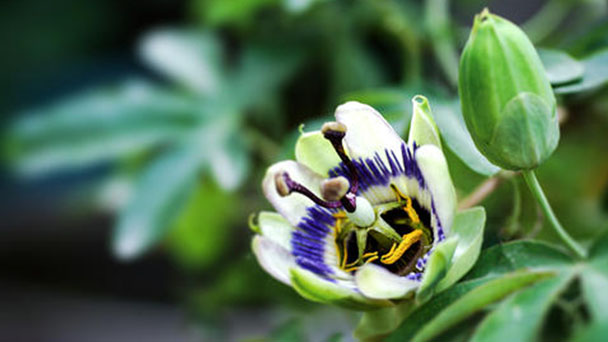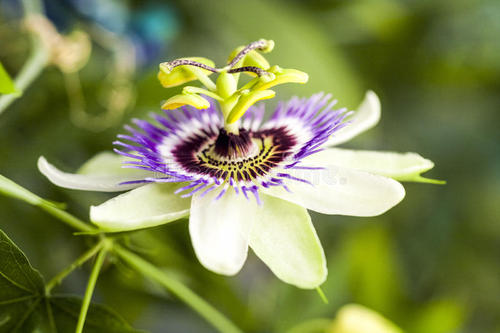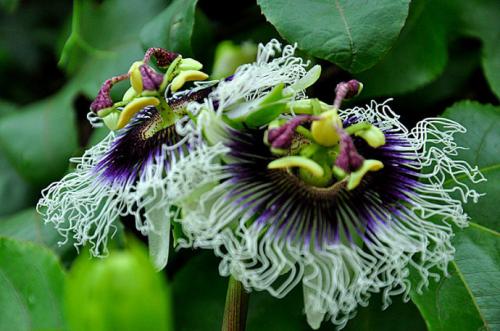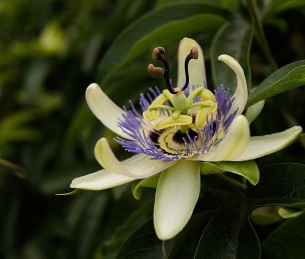Passion flowers profile
Written by Maggie
Jan 14 2021

Passion flowers, scientific name Passiflora, belong to the Passion flowers family, which originated in South America and can be used as ornamental plants in gardens.
Passion flowers picture

Passion flowers morphological characteristics
Passion flowers(Passiflora) stem is cylindrical and slightly angular, glabrous, slightly glaucous; Leaves are paperious, 5-7 cm long, 6-8 cm wide, base cordate, palmately 5-lobed, middle lobes ovate-oblong, bilateral lobes slightly smaller, glabrous, entire; Petiole are 2 -- 3 cm long with 2 -- 4(-6) tiny glands in the middle; Stipules are large, reniform, armphitic, up to 1.2 cm long, margin undulate, cymes degenerated with only 1 flower, opposite to tendrils; Flowers are large, pale green, large, 6-8(-10) cm in diameter; Pedicels are 3-4 cm long; Bracts are broadly ovate, 3 cm long, entire; Passion flowers has 5 sepals, 3-4.5 cm long, pale green on the outside, greenish-white on the inside, outer apex with a horny appendage.
Passion flowers (Passiflora) has 5 petals, pale green, subequal to sepals; Outer corolla lobes have 3 wheels, filiform, outer and middle lobes, 1-1.5 cm long, apical cerulean, middle white, lower purplish red, inner lobes filiform, 1-2 mm long, apical with a purplish head, lower light green; Corolla fimbriate, lobes are purplish red, with 1 dense glandular ring below; . The stamen stalk is 8-10 mm long; Passion flowers have 5 stamens, filaments separated, ca. 1 cm long, flat; Anthers are oblong, ca. 1.3 cm; Ovary is ovoid; Styles are 3-divided, purplish red, ca. 1.6 cm long; Stigma is reformed. Berry ovoid to subglobose, ca. 6 cm long, orange or yellow when ripe; Seeds are numerous, obcordate, ca. 5 mm long. Flowering period is from May to July.
The growth habits of Passion flowers
Originating in South America, Passion flowers (Passiflora) is a perennial evergreen grassy or semi-woody climbing plant. Passion flowers hometown is 1500 meters above sea level in the highlands of Mexico. It is neither cold resistant nor afraid of heat. The climate there is warm and cool, and there is a period of low temperature for dormancy. Passion flowers fruit are sweet, sour and delicious, with strong flavor and pleasant aroma.

Propagation methods of Passion flowers
1. Root division is the most commonly used method of propagation. Passion flowers can only germinate at the neck of the roots, so they must have part of the neck of the roots during the segmentation, otherwise new plants cannot sprout. In order to identify easily, we usually use the method of burying roots in advance to promote bud, and then divide and plant the adventitious buds on the root neck after germination. The method of root division is simple and feasible, with high survival rate and strong seedling, but the number of breeding plants is limited.
2. Cuttage propagation is the main propagation method of Passion flowers, with high propagation coefficient. It is generally carried out in early spring, and also in summer and autumn. The cuttings are taken from the root tuber after accelerating bud, and when the base of the new bud is expanded, the cuttings can be stripped from the base. You can also take more than one section of the base of the new bud, and then take the tender bud of the axillary bud with the growth, so that you can get more cuttings. Spring seedlings by summer and autumn full growth, the year can be flowering. The survival rate of cuttings from September to October was lower than that in spring, but higher than that in summer. The sandy loam with a small amount of leaf rot soil or peat is suitable for interplanting soil.
3. Seed propagation is limited to flower bed varieties and application in breeding. Summer is more hot and humid and poor, so the seeds are more mature from the cool autumn. It is not easy to obtain seeds for vertical varieties and artificial pollination is required. Seeding is generally carried out in the seeding box, about 20C, 4-5 days namely germination unearthed, to be true leaves grow out and then planting, 1-2 years later flowering.
The Passion flowers language
Passion Flowers: Vision
The efficacy and function of Passion flowers
Passion flowers have a strong aroma, sweet, sour and delicious, which can generate fluid and quench thirst, refresh and wake up the brain. After eating, it can increase appetite, promote secretion of digestive glands and help digestion. Passion flowers fruit contains a variety of vitamins, can reduce blood fat, prevention and treatment of arteriosclerosis, reduce blood pressure. It contains up to 165 kinds of compounds, 17 kinds of amino acids and anti-cancer effective ingredients, and can prevent cell aging, canceration, anti-aging, and improve the appearance of the effect.

Latest Updated
- Benefits of Bugleweed - 7 Science-backed Health Benefits
- Bugleweed Dangers & Side Effects - Is It Poisonous?
- How to Plant Evergreen Trees - What You Should Know
- When to Plant Evergreens - Grow Guide for Evergreen Trees
- 12 Wonderful Evergreen Shrubs for Your Garden
- 12 Popular Evergreen Plants with Pictures for Beginners
- When And How To Prune A Lilac Bush Like a Pro
- How to Grow & Care for Lilac Vine (Hardenbergia Violacea)
- Japanese Lilac Tree (Syringa Reticulata) Care & Propagation Guide
- Shumard Oak Pros and Cons - What to Know
Popular Articles
- Winter maintenance of Antirrhinum Majus
- How to Grow Terminalia Mantaly Tree
- How to Grow and Care for Crossostephium Chinense
- How to grow Antirrhinum Majus in spring
- Peristeria Elata (Dove Orchid) Profile: Info & Care Guide
- Underwatered Snake Plant (Sansevieria Trifasciata) - Signs And How To Fix
- How to Care for Brazilian Jasmine Plant (Mandevilla Sanderi)
- How to Grow & Care for Graptopetalum Purple Delight in Summer
- Rosa Chinensis (China Rose): Plant Growing & Care Tips
- How to Care for Baby Sun Rose (Aptenia Cordifolia)